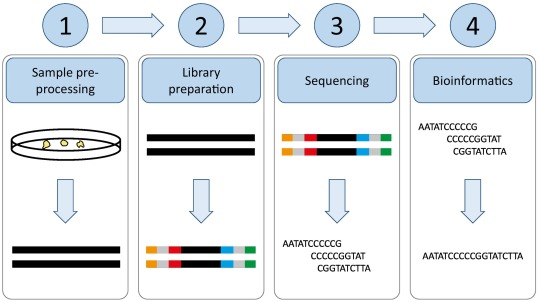Table of Contents
Introduction:
- Next-generation sequencing (NGS) is a high-throughput DNA sequencing technology that allows for the simultaneous sequencing of millions of DNA fragments.
- It has revolutionized the field of genomics, enabling scientists to sequence entire genomes in a relatively short amount of time and at a lower cost.
- The steps involved in NGS can vary depending on the specific platform and method used, but the overall process typically includes sample preparation, library preparation, sequencing, and data analysis.
Steps:
Sample Preparation:
- Sample preparation involves obtaining a DNA sample from the organism of interest.
- Depending on the species and the research question, the DNA can be obtained from various sources, such as blood, tissue, or cells.
- The DNA must be of high quality and quantity, as contaminants and low yields can negatively impact the success of the sequencing.
Library Preparation:
- Library preparation involves processing the DNA sample to produce a set of fragments of a defined length, usually between 200 and 1000 base pairs.
- The fragments are then ligated to adapters, which are short pieces of DNA that serve as primers for the sequencing reaction.
- The adapters also include barcodes, which allow multiple samples to be sequenced in the same lane, making it possible to compare the sequencing data from different samples.
- Library preparation also includes amplification of the DNA fragments, typically by polymerase chain reaction (PCR), to produce enough DNA for the sequencing reaction.
Sequencing:
- Sequencing involves determining the order of nucleotides in the DNA fragments.
- The specific sequencing method used depends on the NGS platform, but generally involves reading the DNA as it is being synthesized, either by fluorescently labeling the nucleotides or by detecting changes in electrical current as they are incorporated into the growing DNA strand.
- The DNA fragments are then clonally amplified, meaning each fragment is copied multiple times, so that enough DNA is present for the sequencing reaction.
- The sequencing reaction generates millions of short sequencing reads, which are usually between 25 and 250 base pairs in length.
Data Analysis:
- Data analysis involves processing the raw sequencing data to generate a set of accurate, contiguous sequences, known as contigs, that represent the target DNA molecule.
- The first step in data analysis is quality control, which involves checking the quality of the sequencing data and removing any poor-quality sequences.
- The next step is alignment, which involves matching the sequencing reads to a reference genome or to a consensus sequence obtained from the contigs.
- The final step is variant analysis, which involves identifying differences between the target DNA and the reference genome, such as single nucleotide polymorphisms (SNPs) and structural variants (SVs).
Conclusion:
- The steps involved in NGS are sample preparation, library preparation, sequencing, and data analysis.
- Each step is critical to the success of the sequencing, and high-quality data depends on the quality and quantity of the DNA sample, the accuracy of the library preparation, and the sensitivity and specificity of the sequencing method.
- Advances in NGS technology continue to make it more accessible, faster, and less expensive, enabling new breakthroughs in our understanding of genetics and the biological world.
